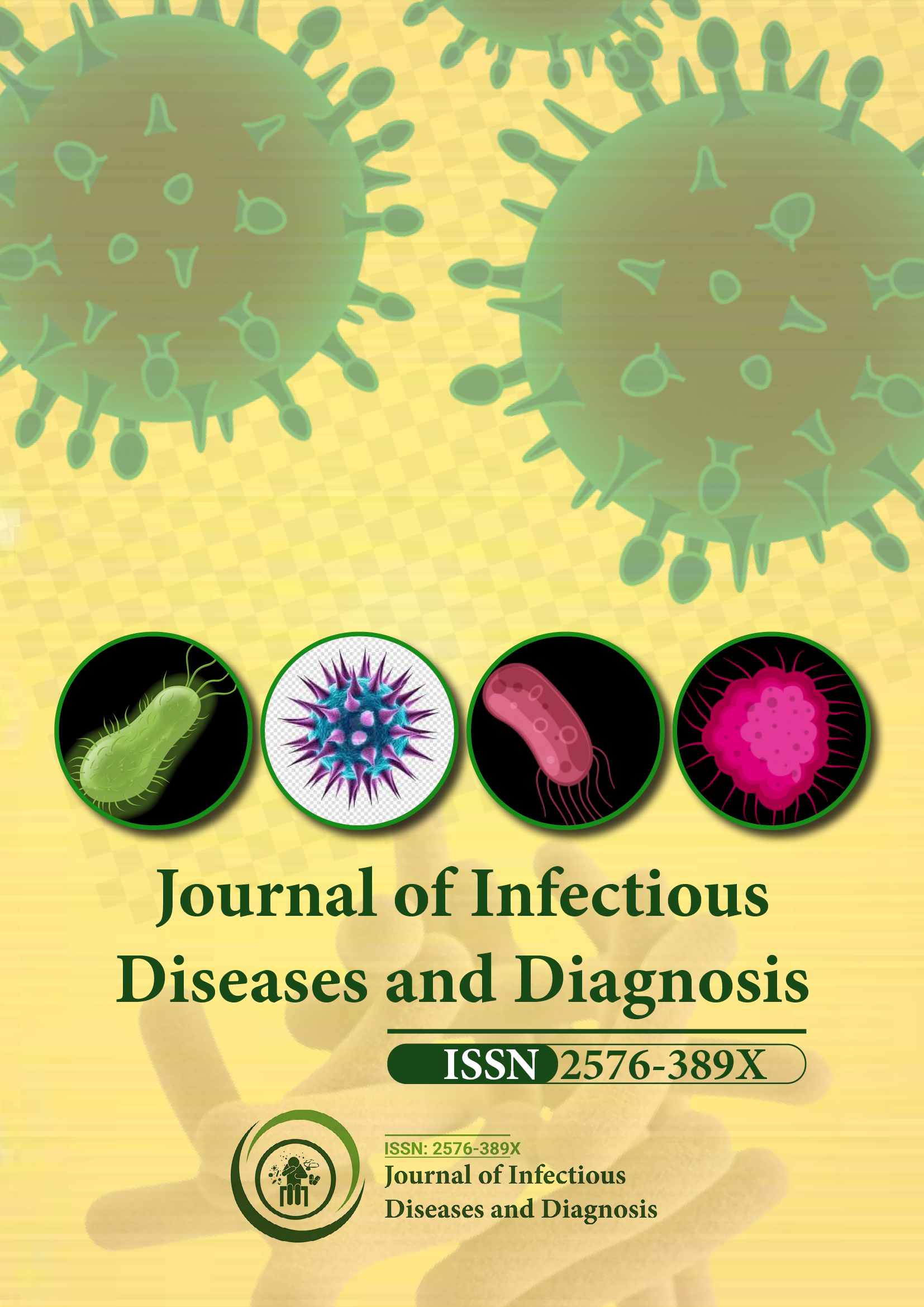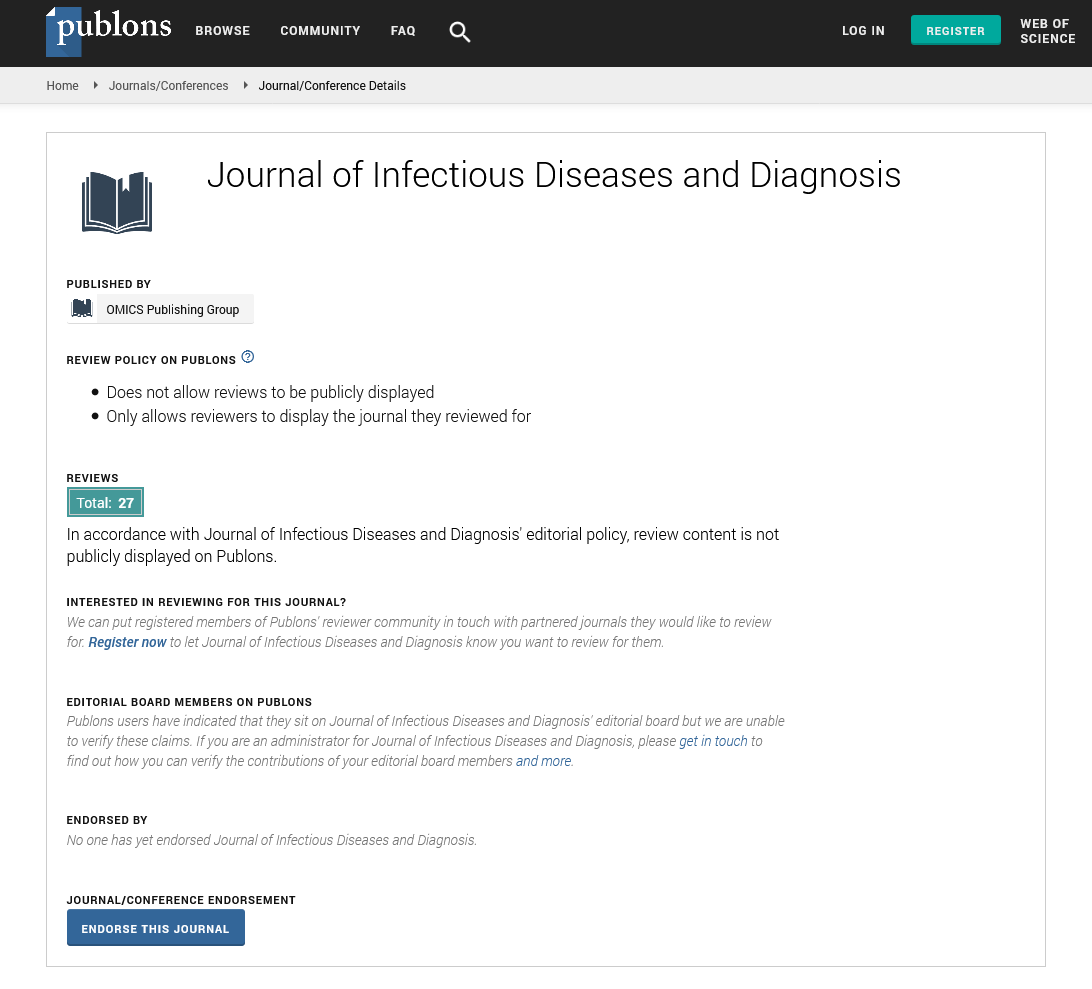Indexed In
- RefSeek
- Hamdard University
- EBSCO A-Z
- Publons
- Euro Pub
- Google Scholar
Useful Links
Share This Page
Journal Flyer

Open Access Journals
- Agri and Aquaculture
- Biochemistry
- Bioinformatics & Systems Biology
- Business & Management
- Chemistry
- Clinical Sciences
- Engineering
- Food & Nutrition
- General Science
- Genetics & Molecular Biology
- Immunology & Microbiology
- Medical Sciences
- Neuroscience & Psychology
- Nursing & Health Care
- Pharmaceutical Sciences
Perspective - (2025) Volume 10, Issue 2
Salmonella in the Modern Era: Insights into Diagnosis, Treatment and Public Health Strategies
Marlon Davison*Received: 25-Feb-2025, Manuscript No. JIDD-25-28668; Editor assigned: 27-Feb-2025, Pre QC No. JIDD-25-28668 (PQ); Reviewed: 14-Mar-2025, QC No. JIDD-25-28668; Revised: 21-Mar-2025, Manuscript No. JIDD-25-28668 (R); Published: 28-Mar-2025, DOI: 10.35248/2576-389X.25.10.322
Description
Salmonella is a common bacterial pathogen responsible for a wide range of gastrointestinal illnesses in humans and animals. It belongs to the family Enterobacteriaceae and includes over 2,500 serotypes. While many infections are self-limiting, certain cases particularly among vulnerable populations such as infants, the elderly and immunocompromised individuals can result in severe illness and even death. The bacterium is a significant cause of foodborne illness worldwide and remains a major concern for public health systems, agriculture and food industries.
Causes and transmission
Salmonella infections are typically transmitted through the consumption of contaminated food or water. Common sources include raw or undercooked eggs, poultry, meat, unpasteurized milk and other dairy products. Fruits and vegetables can also become contaminated during processing or through contact with animal feces. Poor hygiene practices during food handling or preparation often contribute to the spread of the bacteria.
The infection may also be transmitted via contact with infected animals, including reptiles, birds and pets. In some instances, person-to-person transmission occurs when individuals fail to wash their hands thoroughly after using the restroom or before preparing food.
Pathogenesis and symptoms
Once ingested, Salmonella bacteria colonize the intestinal tract, where they invade the epithelial cells lining the intestines. This invasion can lead to inflammation, resulting in the typical symptoms of salmonellosis. The incubation period generally ranges from 6 to 72 hours after exposure. Symptoms usually include: Diarrhoea, sometimes containing blood or mucus, abdominal cramps, fever, nausea and vomiting.
Most individuals recover within a few days without medical treatment. However, dehydration from severe diarrhoea may require hospitalization. In rare cases, the infection can spread from the intestines to the bloodstream and other body sites, leading to conditions like septicemia, which demand immediate medical attention.
Typhoidal and non-typhoidal salmonella
Salmonella infections are classified into two main types: typhoidal and non-typhoidal.
Typhoidal Salmonella, including S. Typhi and S. Paratyphi, causes systemic illnesses such as typhoid and paratyphoid fever. These strains are generally restricted to humans and are transmitted through contaminated food or water. Symptoms are more severe and may include prolonged fever, weakness, abdominal pain and rash. Without treatment, typhoid fever can be life-threatening.
Non-typhoidal Salmonella strains typically cause gastroenteritis and can infect a wide range of animal hosts. These are more common globally and are often linked to contaminated food products.
Diagnosis
Diagnosing salmonellosis involves laboratory testing of stool, blood, or other body fluids to identify the presence of Salmonella bacteria. Culturing the organism allows for confirmation and also helps in determining antibiotic susceptibility, especially in severe or complicated cases.
Treatment and antibiotic resistance
Most people with uncomplicated salmonellosis recover without antibiotics. Supportive care, including adequate hydration and rest, is usually sufficient. In certain populations particularly young children, the elderly, or those with weakened immune systems antibiotics may be prescribed to prevent complications.
However, an increasing challenge in treating Salmonella infections is the emergence of antibiotic-resistant strains. The overuse and misuse of antibiotics in both human medicine and livestock production have contributed to this issue. Multidrugresistant strains, particularly in non-typhoidal Salmonella, complicate treatment and may result in longer illness duration or worse outcomes.
Prevention and control
Preventing Salmonella infections requires a combination of individual, community and industry-level efforts. Key preventive measures include:
Safe food handling: Cooking meat, poultry and eggs thoroughly; avoiding cross-contamination in the kitchen; and keeping raw and cooked foods separate.
Hand hygiene: Washing hands with soap and water after using the bathroom, changing diapers, handling animals, or preparing food.
Proper food storage: Refrigerating perishable foods promptly and avoiding leaving cooked food at room temperature for extended periods.
Water safety: Ensuring access to clean drinking water, especially in areas where waterborne transmission is common.
Vaccination: In regions where typhoid fever is endemic, vaccines are available and recommended, particularly for travelers or atrisk populations.
In the agricultural sector, measures such as monitoring livestock health, improving sanitation in farms and responsible use of antibiotics contribute to reducing the risk of contamination. Food processing industries also play a key role in maintaining hygiene and quality control to limit bacterial contamination during production and packaging.
Global impact and surveillance
Salmonella infections have a substantial impact on global public health. According to the World Health Organization, nontyphoidal Salmonella is responsible for an estimated 93 million infections and 155,000 deaths annually. Typhoid fever, though preventable, still affects millions in low-resource settings, particularly where clean water and sanitation are lacking.
International efforts, including surveillance programs and coordinated response networks, help in tracking outbreaks, identifying contamination sources and implementing timely interventions. Enhanced laboratory capacities and public health education remain essential for reducing the burden of disease.
Conclusion
Salmonella remains a widespread and significant bacterial pathogen affecting people across all age groups. While the majority of infections are manageable, certain strains and conditions can result in severe disease. Through better food safety practices, hygiene, public awareness and global monitoring efforts, the risks associated with Salmonella can be significantly reduced. Continued research and action are needed to address the rising issue of antibiotic resistance and to support health systems in responding effectively to outbreaks.
Citation: Davison M (2025). Salmonella in the Modern Era: Insights into Diagnosis, Treatment and Public Health Strategies. J Infect Dis Diagn. 10:322.
Copyright: © 2025 Davison M. This is an open-access article distributed under the terms of the Creative Commons Attribution License, which permits unrestricted use, distribution and reproduction in any medium, provided the original author and source are credited.

